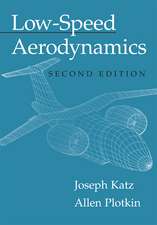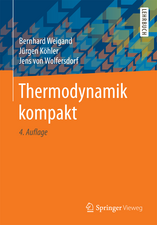Analytical Methods for Heat Transfer and Fluid Flow Problems
Autor Bernhard Weiganden Limba Engleză Paperback – 13 oct 2010
| Toate formatele și edițiile | Preț | Express |
|---|---|---|
| Paperback (2) | 390.25 lei 6-8 săpt. | |
| Springer Berlin, Heidelberg – 22 mai 2015 | 390.25 lei 6-8 săpt. | |
| Springer Berlin, Heidelberg – 13 oct 2010 | 696.02 lei 6-8 săpt. | |
| Hardback (1) | 397.76 lei 6-8 săpt. | |
| Springer Berlin, Heidelberg – 22 mai 2015 | 397.76 lei 6-8 săpt. |
Preț: 696.02 lei
Preț vechi: 818.85 lei
-15% Nou
Puncte Express: 1044
Preț estimativ în valută:
133.23€ • 144.76$ • 111.98£
133.23€ • 144.76$ • 111.98£
Carte tipărită la comandă
Livrare economică 21 aprilie-05 mai
Preluare comenzi: 021 569.72.76
Specificații
ISBN-13: 9783642060793
ISBN-10: 364206079X
Pagini: 280
Ilustrații: XX, 258 p.
Dimensiuni: 155 x 235 x 15 mm
Greutate: 0.4 kg
Ediția:2004
Editura: Springer Berlin, Heidelberg
Colecția Springer
Locul publicării:Berlin, Heidelberg, Germany
ISBN-10: 364206079X
Pagini: 280
Ilustrații: XX, 258 p.
Dimensiuni: 155 x 235 x 15 mm
Greutate: 0.4 kg
Ediția:2004
Editura: Springer Berlin, Heidelberg
Colecția Springer
Locul publicării:Berlin, Heidelberg, Germany
Public țintă
GraduateCuprins
Linear Partial Differential Equations.- Heat Transfer in Pipe and Channel Flows (Parabolic Problems).- Analytical Solutions for Sturm — Liouville Systems with Large Eigenvalues.- Heat Transfer in Duct Flows for Small Peclet Numbers (Elliptic Problems).- Nonlinear Partial Differential Equations.
Recenzii
From the reviews:
"The main aim of the present book is to show the usefulness of analytical methods, in a world, which focuses more and more on numerical methods. … The book is written for graduate students and engineers. … At the end of every chapter, problems are shown, which the reader may solve to check his/her knowledge." (Claudia-Veronika Meister, Zentralblatt MATH, Vol. 1073, 2005)
"The intention of the author of this modest little book is to provide a guide for analytic methods for the solution of heat transfer problems. … A list of symbols is provided at the start, some 200 references are cited, and there is a shortish index. … The author intends his book for graduate students and engineers. … It will mainly serve as a reference for those interested in technical heat transfer calculations." (A. C. Fowler, Journal of Fluid Mechanics, Vol. 547, 2006)
"The main aim of this book is to ‘show the usefulness of analytical methods in a world which focuses more and more on numerical methods (in heat transfer and fluid flow)’. The intended readership is researchers from the relevant engineering community and their students. … the mathematician can use the book as an entrée to selected parts of the engineering literature, both theoretical and experimental." (J. R. Ockendon, Mathematical Reviews, Issue 2005 h)
"Analytical methods for heat transfer and fluid flow problems is designed to show the usefulness of analytical methods for solving problems … . The book’s target audience is engineers and engineering students, people with a good understanding of basic engineering mathematics. … The book is laid out clearly, making good use of tables and graphs when necessary. All problems are solved in clear steps … . It’s a useful reference for those working in this field … ." (Ragan Nelson, The Chemical Engineer, October, 2006)
"The main aim of the present book is to show the usefulness of analytical methods, in a world, which focuses more and more on numerical methods. … The book is written for graduate students and engineers. … At the end of every chapter, problems are shown, which the reader may solve to check his/her knowledge." (Claudia-Veronika Meister, Zentralblatt MATH, Vol. 1073, 2005)
"The intention of the author of this modest little book is to provide a guide for analytic methods for the solution of heat transfer problems. … A list of symbols is provided at the start, some 200 references are cited, and there is a shortish index. … The author intends his book for graduate students and engineers. … It will mainly serve as a reference for those interested in technical heat transfer calculations." (A. C. Fowler, Journal of Fluid Mechanics, Vol. 547, 2006)
"The main aim of this book is to ‘show the usefulness of analytical methods in a world which focuses more and more on numerical methods (in heat transfer and fluid flow)’. The intended readership is researchers from the relevant engineering community and their students. … the mathematician can use the book as an entrée to selected parts of the engineering literature, both theoretical and experimental." (J. R. Ockendon, Mathematical Reviews, Issue 2005 h)
"Analytical methods for heat transfer and fluid flow problems is designed to show the usefulness of analytical methods for solving problems … . The book’s target audience is engineers and engineering students, people with a good understanding of basic engineering mathematics. … The book is laid out clearly, making good use of tables and graphs when necessary. All problems are solved in clear steps … . It’s a useful reference for those working in this field … ." (Ragan Nelson, The Chemical Engineer, October, 2006)
Textul de pe ultima copertă
Although the solution of Partial Differential Equations by numerical methods is the standard practice in industries, analytical methods are still important for the critical assessment of results derived from advanced computer simulations and the improvement of the underlying numerical techniques. Literature devoted to analytical methods, however, often focuses on theoretical and mathematical aspects and is therefore useless to most engineers. Analytical Methods for Heat Transfer and Fluid Flow Problems addresses engineers and engineering students. It describes useful analytical methods by applying them to real-world problems rather than solving the usual over-simplified classroom problems. The book demonstrates the applicability of analytical methods even for complex problems and guides the reader to a more intuitive understanding of approaches and solutions.
Caracteristici
Easy-to-understand approach to mathematically difficult methods for engineers and engineering students Enables the reader to evaluate the results of advanced computer programs Includes supplementary material: sn.pub/extras Request lecturer material: sn.pub/lecturer-material
Notă biografică
Professor Weigand studied Mechanical Engineering at the Technical University of Darmstadt, where he was also research assistant at the Institute for Technical Thermodynamics. After his Ph.D. in 1992, he was employed at ABB Power Generation LtD in Baden / Switzerland. There he was responsible for the cooling design of all new gas turbine blades and for the basic research on Heat Transfer and Cooling. Since 1999, he is Professor for Thermodynamics at the University of Stuttgart.


















